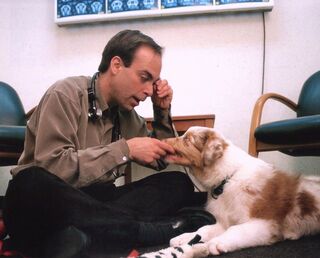Ethics and Morality
The Moments That Define Us
How will we carry them years later?
Posted December 7, 2020
We had just dipped our toes in the third year of vet school. With a wild-eyed excitement that had snowballed all summer—after two grueling years spent in lectures and labs in a torrent of formaldehyde, microscopes, and specimens—we were finally entrusted with our first chance in clinics. With stethoscopes draped round our necks, proudly worn as badges; manure-stained khaki overalls and blue scrub suits in hand; and student-length, white clinic coats (and in their pockets our bibles of notes as well as a small cache of instruments), we could now join the ranks of the upperclassmen to walk through the doors of the hallowed halls. Within those teaching hospital walls, though much of our duties took place late at night—checking on patients, meting out treatments, and scribbling our bleary-eyed notes in their charts, while still keeping up with a full day of classes—twice weekly we’d meet with real patients and clients while senior clinicians, their interns, and residents watched us and guided each step of the way. And though we’d only begun working with our first patients, it seemed what we learned in our classes each day took on a grand new relevance.
While spreading our wings as soon-to-be doctors meant taking on duties we’d dreamed of for years, it also led us into roles we’d dreaded. That fall we were plunged into one that was both: the realm of junior surgery. As freshmen we’d toiled in time-honored tradition through a formalin haze among well-preserved tissues, dissecting cadavers with meticulous care. At last it was time, as we started in clinics, to apply what we’d learned to real, living beings, before we stepped into the surgery suite. To do so, however, required we first work with dogs who had run out of time in a shelter.
As vet students, certainly, we were well versed in the daunting statistics of pets in this country: 70,000 dogs and cats born every day; 70 million living as strays; 6 to 8 million enter shelters every year, and well more than half of these tragically end up euthanized. Perhaps saddest of all, another 30 million more die every year of neglect, cruelty, and mishandling.
Knowing these cold, hard statistics is one thing, but facing them firsthand is quite something else. Putting a few of these dogs in our care on the day they were due to be euthanized forced us to take matters personally. For, in spite of our kindness and gentle attention, commitment and diligence in tending to them, sterile technique, leading-edge anesthetics, and a crackerjack team of clinicians at hand, in the end our procedures were terminal. Surgery—even when expertly done—once over is painful, takes time to heal, and can challenge both human and animal patients. So policy, ethics, and above all compassion dictated we would not cause them more pain than if they had been put to sleep at the shelter.
Each week in the morning, well before we’d begin, I could see our class buzzing with anticipation. This time it was us who were holding the scalpel, ligating the vessels, suturing skin, administering anesthesia, and tracking each vital sign. Yet, prepared as we were from reviewing the textbooks— going over each step in the finest detail so once we were scrubbed in we knew them by heart—we felt the full weight and responsibility of caring for those creatures whose lives were in our hands.
At lunchtime while most of our classmates were eating and reviewing their surgery notes one last time, a few of us quietly slipped away to the kennel where the dogs stayed until lab began. Without many words but a look in our eyes that clearly expressed why we each were there, we opened the door and walked into the kennel to meet the dogs we would be working with soon—to take them for a walk; play with them on the lawn; let them sniff at a lamppost, the bushes, the trees; sit with them on the grass and do nothing together; pet them and hug them; let them know that we cared. At times in that hour, we’d catch a glimpse of each other and I saw in their faces what I’m sure was in mine: a respect for the lives of the dogs we were with.
That first afternoon, just before our procedures, while all of us scrubbed and got into our gowns, a few of our classmates asked why we came early, why we put ourselves through that ordeal. To be sure, it was painful, but also essential, the five of us felt, to go on with the surgery. And we did so each week for the rest of the quarter till junior surgery classes were done.
Times have changed quite a bit in the past twenty years. Notwithstanding the statistics of unwanted pets—the millions abandoned, abused, and euthanized—simulations and models now take the place of live animals for training vet students in surgery labs. I still think of those dogs, though, all these years later—the joy in their faces as we walked into the kennel; their simple abandon in our hour together; that soft, grateful look when their eyes would meet mine. And given what was required of us in that era of training, I could not help but choose to spend that hour with them.



